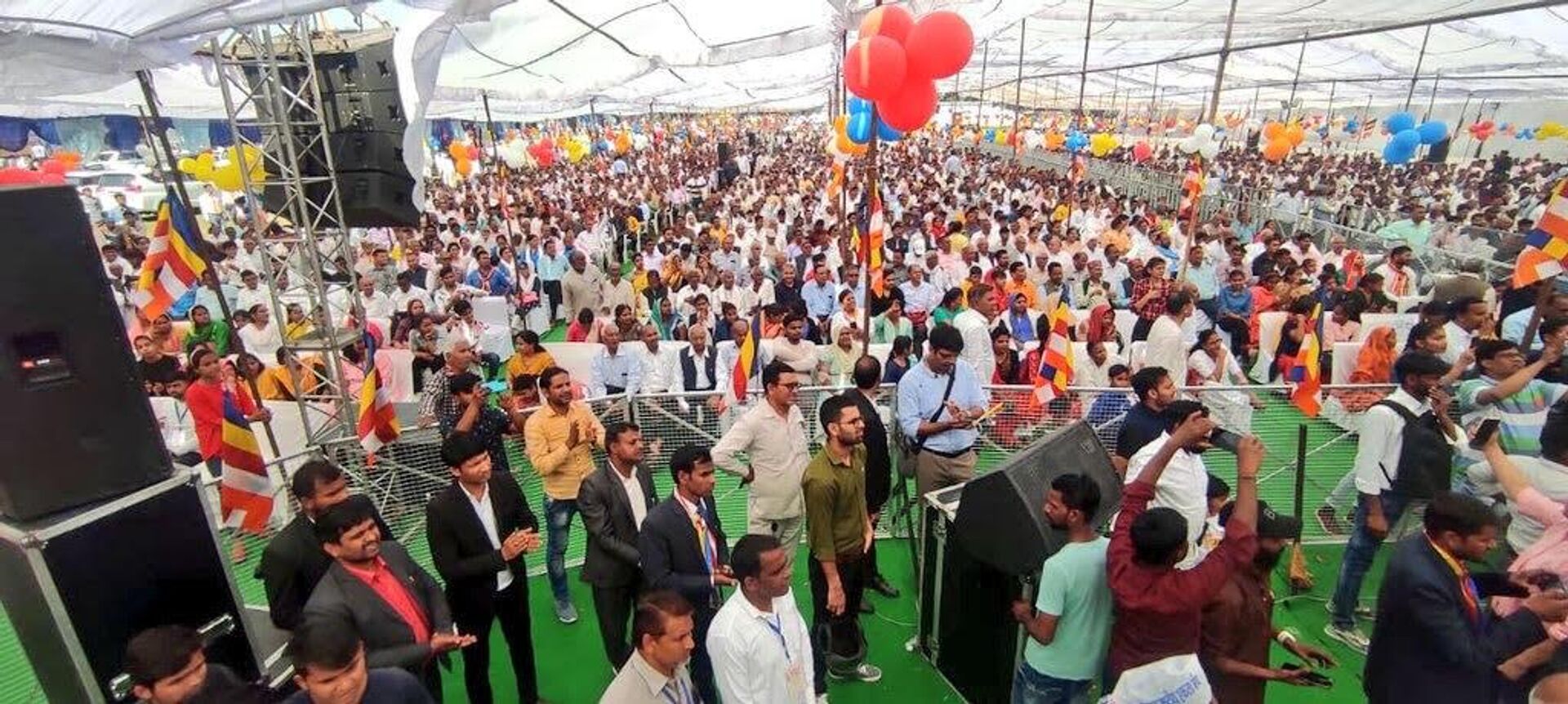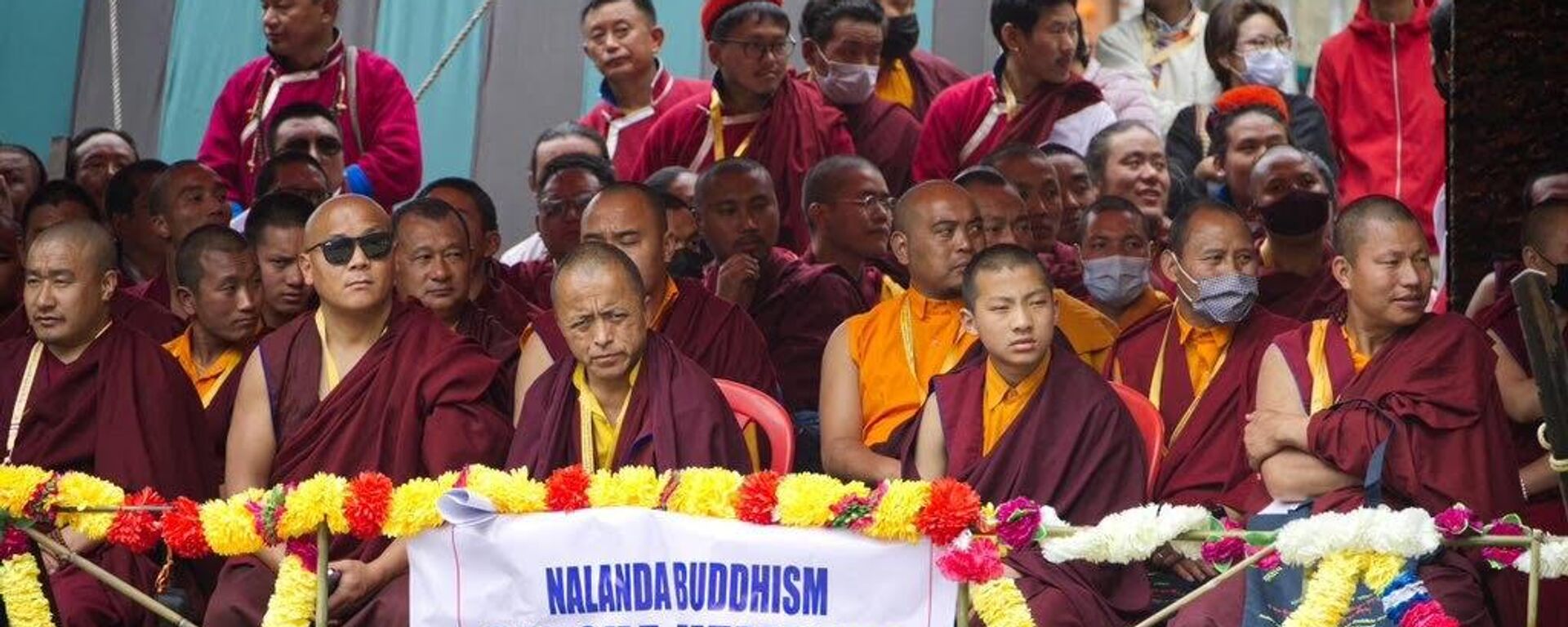https://sputniknews.in/20230428/buddhism-gaining-popularity-among-lower-castes-in-india-says-non-profit-organisation-1721452.html
Buddhism Gaining Popularity Among Lower Castes in India, Says Non-Profit Organisation
Buddhism Gaining Popularity Among Lower Castes in India, Says Non-Profit Organisation
Sputnik India
There has been a “surge in popularity” of Buddhism among socially and economically backwards Hindus in the last ten years, an Indian social group advocating for an “egalitarian society” has told Sputnik.
2023-04-28T14:46+0530
2023-04-28T14:46+0530
2023-04-28T17:19+0530
sputnik opinion
tibetan buddhism
india
dalits
hindu
hindu deities
https://cdn1.img.sputniknews.in/img/07e7/04/1c/1729405_0:92:3315:1957_1920x0_80_0_0_02eea48066f00c5999bf932894577b7a.jpg
Buddhism has seen a “surge in popularity” among socially- and economically-backward Hindus over the last ten years, an Indian social group advocating for an “egalitarian society” has told Sputnik.The group held an event in New Delhi last October, which witnessed around 7,000 people changing their religion to Buddhism. “Around 26,000 had embraced Buddhism from other locations at that event. The venue couldn’t accommodate more than 7,000 people,” Ishwar Singh, the general secretary of Mission Jai Bheem, told Sputnik.He said that around 19,000 people in Gujarat, nearly 8,000 in Rajasthan and around 27,000 in Uttar Pradesh are in touch with the organisation to convert in the coming days.Singh said that many other Indian organisations are also “actively working” to help people “liberate themselves” by embracing Buddhism.Why are Indians Turning to Buddhism?Singh, who is a resident of Delhi, claimed that he received several “complaints” by people from lower social castes being subjected to “discrimination” from the authorities and the public at large in everyday life.The Indian Parliament passed a stringent legislation, the Scheduled Castes and Tribes (Prevention of Atrocities Act), in 1990. However, Singh said that in reality, crimes against lower-caste Hindus continue to take place with a “very low rate of prosecution”.Hinduism's Four-Tier Social Ladder According to Hindu religious scriptures, Hindu society is classified into four strata—Brahmins (priests, intellectuals and all others at the top of the social ladder), Kshatriyas (warriors, police, administrators who are the second most influential grouping), and Vaishyas (merchants and traders).‘Shrudhas’, or the Dalits or ‘untouchables’, which consist of workers and labourers, occupy the lowest rung on the caste system's ladder.Singh underscored that the Indian Constitution, which was formally unveiled in 1950, classified the ‘shrudhas’ under the category of Scheduled Castes (SC), and Scheduled Tribes (STs).As per India’s last official census in 2011, SCs comprised 201.4 million out of India’s 1.2 billion people. The ST population, on the other hand, stood at over 104 million. Together, the two groups constituted roughly 25% of the Indian population.Separately, the Indian Constitution also classified the Other Backward Caste (OBC) as a separate category, which comprised communities which are ‘educationally backward’. But since Independence, many of the OBCs consider themselves to be a separate category and not part of the Dalit Community.While the Indian authorities have never released official figures about the OBC population, a study by the National Sample Survey Organisation (NSSO) in 2007 found that OBCs made up nearly 45% of India’s population.The Constitution also guarantees the right to government jobs for people from lower castes, akin to a ‘positive discrimination’ policy in the United Kingdom.B.R Ambedkar’s Role in Indian Buddhism MovementBhim Rao Ambedkar, the chief architect of the Indian constitution, is widely regarded as the founder of the Indian Buddhism movement.Ambedkar reinterpreted the original Nalanda Buddhism and saw it as a means for lower-caste Hindus to escape the clutches of the four-tier system.Ambedkar converted to Buddhism in 1956 and subsequently developed a ‘Navayana’ (new vehicle) Buddhism, Singh said.These vows ask the new coverts to renounce their former faith in Hindu gods and deities, shun intoxicants and believe that they are having a “re-birth”.As in original Buddhism, the Ambedkar’s version tells its followers to follow in the footsteps of Buddha by believing in Buddha ‘dhamma’.Moreover, he said that the Buddhism prevalent in the states bordering China (Arunachal Pradesh, Sikkim, West Bengal, Uttarakhand, Himachal Pradesh, Ladakh UT, and so on) differs from the interior parts of the country."The territory at the border is contiguous to Tibet (Tibet Autonomous Region) where Buddhism has been present for centuries. But in the interior parts of India, Hinduism has been the major religion. So, there is bound to be backlash as people leave Hinduism for Buddhism," Singh noted.
https://sputniknews.in/20230418/india-holds-conference-near-china-border-to-reinforce-claim-on-buddhism-1598341.html
india
Sputnik India
feedback.hindi@sputniknews.com
+74956456601
MIA „Rossiya Segodnya“
2023
Dhairya Maheshwari
https://cdn1.img.sputniknews.in/img/07e6/0c/13/138962_0:0:641:640_100x100_80_0_0_2cb44360dbcdf6d84bf4b299cd045917.jpg
Dhairya Maheshwari
https://cdn1.img.sputniknews.in/img/07e6/0c/13/138962_0:0:641:640_100x100_80_0_0_2cb44360dbcdf6d84bf4b299cd045917.jpg
News
en_IN
Sputnik India
feedback.hindi@sputniknews.com
+74956456601
MIA „Rossiya Segodnya“
Sputnik India
feedback.hindi@sputniknews.com
+74956456601
MIA „Rossiya Segodnya“
Dhairya Maheshwari
https://cdn1.img.sputniknews.in/img/07e6/0c/13/138962_0:0:641:640_100x100_80_0_0_2cb44360dbcdf6d84bf4b299cd045917.jpg
dalit movement in india, dalit population, caste system in india, caste discrimination in india, sc st atrocities act, global buddhist summit
dalit movement in india, dalit population, caste system in india, caste discrimination in india, sc st atrocities act, global buddhist summit
Buddhism Gaining Popularity Among Lower Castes in India, Says Non-Profit Organisation
14:46 28.04.2023 (Updated: 17:19 28.04.2023) As India hosted the first-ever Global Buddhism Summit last week, we take a look at the “rising popularity” of Buddhism in India. Buddhists made up just a 0.7% of the Indian population in 2011. But Mission Jai Bheem, a Buddhist non-profit group, claimed that many lower-caste Hindus are turning to Buddhism.
Buddhism has seen a “surge in popularity” among socially- and economically-backward Hindus over the last ten years, an Indian social group advocating for an “egalitarian society” has told Sputnik.
‘Mission Jai Bheem’, a New Delhi-headquartered group, has vowed to “bring back” 100 million people, to the fold of Buddhism by 2025. The group was founded in 2020.
The group held an event in New Delhi last October, which witnessed around 7,000 people changing their religion to Buddhism. “Around 26,000 had embraced Buddhism from other locations at that event. The venue couldn’t accommodate more than 7,000 people,” Ishwar Singh, the general secretary of Mission Jai Bheem, told Sputnik.
He said that around 19,000 people in Gujarat, nearly 8,000 in Rajasthan and around 27,000 in Uttar Pradesh are in touch with the organisation to convert in the coming days.
Singh said that in the lead-up to 2025, the group has divided its work into four phases. “In the first phase, we achieved the target of bringing back 26,000 people to Buddhism. In the second phase (ongoing), our target is 100,000. The third phase's target is 1 million. And by 2025, we aim to get 100 million Buddhism converts,” he said.
Singh said that many other Indian organisations are also “actively working” to help people “liberate themselves” by embracing Buddhism.
Why are Indians Turning to Buddhism?
“One of the major reasons why people are embracing Buddhism is because of rising religious radicalisation in Indian society. The age-old notions of the Hindu ‘varna’ system are still very much present in Indian society, both in urban and rural areas. Those at the bottom of this system continue to face discrimination,” Singh explained.
Singh, who is a resident of Delhi, claimed that he received several “complaints” by people from lower social castes being subjected to “discrimination” from the authorities and the public at large in everyday life.
“We see incidents of people from lower social communities being denied entry to temples or being denied water rights from the common village well or water sources. At many places, lower-caste Hindu grooms are not allowed to ride on a horse during marriage (in Hinduism, it is customary for grooms to ride a horse on their wedding day),” stated Singh.
The Indian Parliament passed a stringent legislation, the Scheduled Castes and Tribes (Prevention of Atrocities Act), in 1990. However, Singh said that in reality, crimes against lower-caste Hindus continue to take place with a “very low rate of prosecution”.
Hinduism's Four-Tier Social Ladder
According to Hindu religious scriptures, Hindu society is classified into four strata—Brahmins (priests, intellectuals and all others at the top of the social ladder), Kshatriyas (warriors, police, administrators who are the second most influential grouping), and Vaishyas (merchants and traders).
‘Shrudhas’, or the Dalits or ‘untouchables’, which consist of workers and labourers, occupy the lowest rung on the caste system's ladder.
Singh underscored that the Indian Constitution, which was formally unveiled in 1950, classified the ‘shrudhas’ under the category of Scheduled Castes (SC), and Scheduled Tribes (STs).
As per India’s last official census in 2011, SCs comprised 201.4 million out of India’s 1.2 billion people. The ST population, on the other hand, stood at over 104 million. Together, the two groups constituted roughly 25% of the Indian population.
Separately, the Indian Constitution also classified the Other Backward Caste (OBC) as a separate category, which comprised communities which are ‘educationally backward’. But since Independence, many of the OBCs consider themselves to be a separate category and not part of the Dalit Community.
While the Indian authorities have never released official figures about the OBC population, a study by the National Sample Survey Organisation (NSSO) in 2007 found that OBCs made up nearly 45% of India’s population.
The Constitution also guarantees the right to government jobs for people from lower castes, akin to a ‘positive discrimination’ policy in the United Kingdom.
B.R Ambedkar’s Role in Indian Buddhism Movement
Bhim Rao Ambedkar, the chief architect of the Indian constitution, is widely regarded as the founder of the Indian Buddhism movement.
Ambedkar reinterpreted the original Nalanda Buddhism and saw it as a means for lower-caste Hindus to escape the clutches of the four-tier system.
Ambedkar converted to Buddhism in 1956 and subsequently developed a ‘Navayana’ (new vehicle) Buddhism, Singh said.
“The only difference between Ambedkar’s Buddhism and the original Buddhism, was that adherents of the newer version are asked to take 22 vows,” Singh noted.
These vows ask the new coverts to renounce their former faith in Hindu gods and deities, shun intoxicants and believe that they are having a “re-birth”.
As in original Buddhism, the Ambedkar’s version tells its followers to follow in the footsteps of Buddha by believing in Buddha ‘dhamma’.
Moreover, he said that the Buddhism prevalent in the states bordering China (Arunachal Pradesh, Sikkim, West Bengal, Uttarakhand, Himachal Pradesh, Ladakh UT, and so on) differs from the interior parts of the country.
"The territory at the border is contiguous to Tibet (Tibet Autonomous Region) where Buddhism has been present for centuries. But in the interior parts of India, Hinduism has been the major religion. So, there is bound to be backlash as people leave Hinduism for Buddhism," Singh noted.




